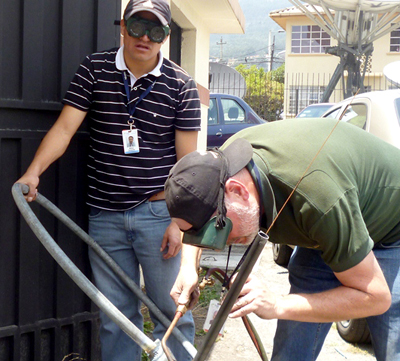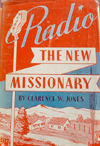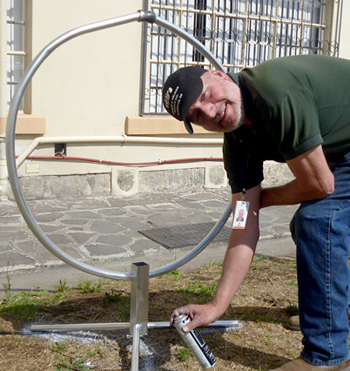 |
| While Milton Camacho looks on, HCJB Global engineer Tim Zook welds a special loop antenna used in the recent DRM digital radio demonstration in Quito. |
(Oct. 12, 2012 - by Ralph Kurtenbach) If not for the lore surrounding Radio Station HCJB's early endeavors into radio broadcasting in Ecuador, Tim Zook could be discouraged as he and other engineers strive to demonstrate digital radio technologies to the authorities and that South American country.
Interviewed recently, Zook offered a kind of nervous chuckle to the question, "Who are your listeners?" Then shrugging off the answer's negative interpretations, he answered, "Well, nobody here has a [digital] radio."
The answer was at least partly right. Like much of the world's population, Ecuadorians still listen to analog radio which utilizes a technique for modulating radio waves and transmitting them in a continuous flow of data. It's a standard established decades ago.
Authorities at Supertel (Superintendencia de Telecomunicaciones, Ecuador's telecommunications department) were provided with a digital radio to monitor the programming aired by the digital medium wave (AM) station that Zook and a colleague, Milton Pumisacho, set up. They had been working with Supertel and the Unión Nacional de Periodistas (National Journalists Union) at a temporary site in the south Quito's Chillogallo sector.
Zook observed that the number of digital receivers in Ecuador is even fewer than the dozen or so AM radio sets known to exist in Quito on Christmas Day, 1931, when the first broadcasts were aired on Radio Station HCJB.
 |
"With no regular broadcast stations to listen to and the exorbitantly high cost of a radio receiver, it was easy to understand the lack of receivers and lack of interest in obtaining them," wrote Jones in his book, Radio: The New Missionary, published by Moody Press in 1948.
Continuing the "chicken or egg" question before those early radio pioneers, Jones continued, "While the fact that radio was just beginning to be used in this lovely 'Switzerland of South America' constituted a glorious opportunity and thrilling challenge for pioneer missionary broadcasting, it also posed a staggering problem-broadcasting without listeners!"
Jones even compared the radio enterprise to establishing a gas station in an area without cars. History reveals, however, that radio communications in Ecuador eventually attained critical mass with more and more Ecuadorians listening to and owning radios.
Jones himself took on the job of promoting radio sales, helping advertise the businesses that imported them and later manufacturing fixed-tuned devices via the Radio Circle, an early outreach of the station.
Radio became part of the fabric of Ecuadorian society and for many HCJB, the Voice of the Andes, set the rhythms of daily life.
 |
| Tim Zook spray paints the loop antenna. |
As implied by the term "digital," the audio signal is digitized and transmitted using a digital modulation scheme. The station staff and more so, the engineers at the HCJB Global Technology Center in Elkhart, Ind., collaborate with the Digital Radio Mondiale (DRM) consortium of broadcasters, transmitter manufacturers and makers of radio receivers. For example, a digital exciter (a modulator that facilitates simulcast in different bandwidths and allows photos to be displayed on some receivers) has been developed.
Earlier research and test broadcasts explored digital shortwave at Radio Station HCJB in Quito, but this marks some of the first testing of the DRM standard in medium wave for use by local radio stations.
However, questions-and even doubts about the standard's viability-swirl around DRM technology as well as other digital broadcast standards. One year ago Supertel requested that the station demonstrate DRM as part of its appraisal of available digital broadcast standards.
"What they're trying to do is to decide on the best system of digital radio for the country," Zook explained. "They're looking at DRM of course. They're also looking at a Japanese system, Integrated Services Digital Broadcasting (ISDB), and a U.S. system that is called HD (known both as HD Radio and IBOC-in band, on channel-owned by Ibiquity Digital)."
Elsewhere in Latin America, the telecommunications authorities in Brazil are expected to announce by late this year that country's digital broadcasting standard. A DRM media statement said that with the Oct. 1 launch in São Paulo of the Brazilian DRM Multi-Sector Platform "all interested parties and stakeholders, including the listeners" would benefit and better understand the DRM standard. Brazil is considered to be a strategic region as it is one of the largest radio markets in the world.
Source: HCJB Global
